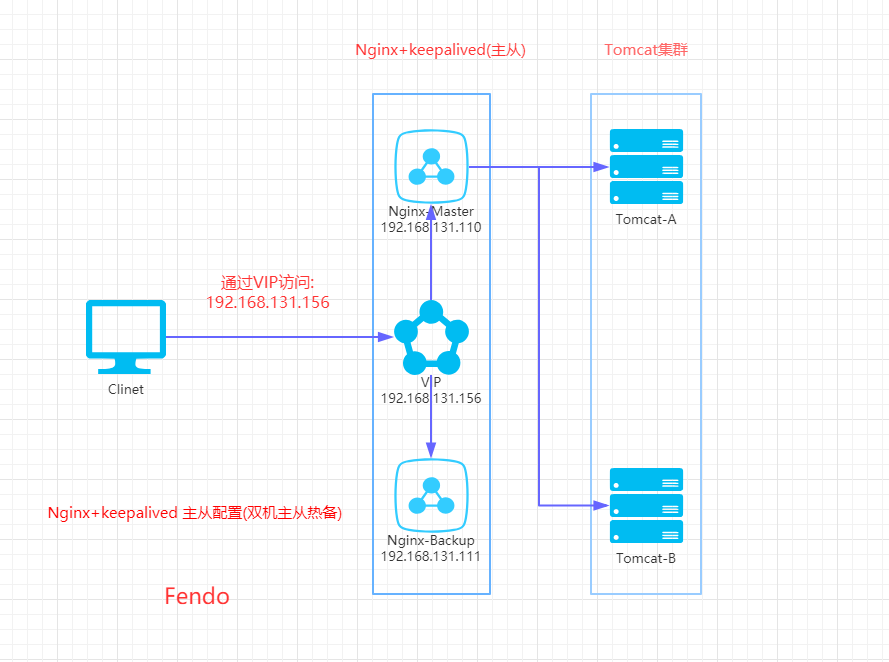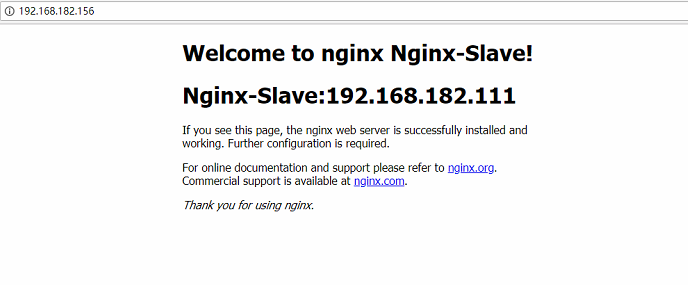简介
这种方案,使用一个VIP地址,前端使用2台机器,一台做主,一台做备,但同时只有一台机器工作,另一台备机在主机器不出现故障的时候,永远处于浪费状态,对于服务器不多的网站,该方案并不经济实惠。
一、网络拓扑
四台虚拟机如下所示:
为什么使用keepalived呢?
使用keepalived就用来做高可用的,提供虚拟VIP
二、软件安装
Nginx-Master和Nginx-Slave两台服务器上的安装操作完全一样
1、更新系统[root@Nginx-Master ~]# yum -y update2、安装依赖软件
[root@Nginx-Master ~]# yum install -y libnl* [root@Nginx-Master ~]# yum -y install openssl openssl-devel kernel-devel #可分别安装 [root@Nginx-Master ~]# yum -y install gcc gcc-c++ autoconf automake make #可分别安装 [root@Nginx-Master ~]# yum install -y libnfnetlink-devel zlib zlib-devel gcc gcc-c++ openssl openssl-devel openssh
说明:
pcre: 用来作地址重写的功能。zlib:nginx 的gzip模块,传输数据打包,省流量(但消耗资源)。
openssl:提供ssl加密协议
安装 mailx 包,用于发送邮件
[root@Nginx-Master ~]# yum -y install mailx [root@Nginx-Master ~]# mailx -V 12.5 7/5/10 [root@Nginx-Master ~]# vim /etc/nail.rc set [email protected](邮箱地址) set smtp=smtp.163.com(smtp服务器) set [email protected](用户名) set smtp-auth-password=xxxxxxxx(邮箱密码) set smtp-auth=login测试
[root@Nginx-Master ~]echo 123 | mailx -v -s "test" [email protected] [root@Nginx-Master ~]echo "hello world" | mail -s 'test666' [email protected] 或者 [root@Nginx-Master ~]mailx -v -s "test" [email protected]<test.txt
3、安装keepalived和nginx
3.1.1、下载
[root@Nginx-Master ~]# cd /usr/local/src/ [root@Nginx-Master src]# wget http://nginx.org/download/nginx-1.9.7.tar.gz [root@Nginx-Master src]# wget wget http://www.keepalived.org/software/keepalived-1.3.5.tar.gz3.1.2、解压
[root@Nginx-Master src]# tar -zvxf nginx-1.9.7.tar.gz [root@Nginx-Master src]# cd nginx-1.9.73.1.3、建立Nginx用户
[root@Nginx-Master nginx-1.9.7]# groupadd -g 1001 nginx [root@Nginx-Master nginx-1.9.7]# useradd -u 900 nginx -g nginx -s /sbin/nologin [root@Nginx-Master nginx-1.9.7]# tail -1 /etc/passwd nginx:x:900:1001::/home/nginx:/sbin/nologin3.1.4、安装Nginx
[root@Nginx-Master nginx-1.9.7]#./configure --prefix=/usr/local/nginx --with-http_dav_module --with-http_stub_status_module --with-http_addition_module --with-http_sub_module --with-http_flv_module --with-http_mp4_module --with-http_ssl_module --with-http_gzip_static_module --user=nginx --group=nginx && make && make install [root@Nginx-Master nginx-1.9.7]# ln -s /usr/local/nginx/sbin/* /usr/local/sbin/3.1.5、安装keepalived
[root@Nginx-Master src]# tar -zvxf keepalived-1.3.5.tar.gz [root@Nginx-Master src]# cd keepalived-1.3.5 [root@Nginx-Master keepalived-1.3.5]# ./configure Keepalived configuration ------------------------ Keepalived version : 1.3.5 Compiler : gcc Preprocessor flags : -I/usr/include/libnl3 Compiler flags : -Wall -Wunused -Wstrict-prototypes -Wextra -g -O2 Linker flags : Extra Lib : -lcrypto -lssl -lnl-genl-3 -lnl-3 Use IPVS Framework : Yes IPVS use libnl : Yes IPVS syncd attributes : No IPVS 64 bit stats : No fwmark socket support : Yes Use VRRP Framework : Yes Use VRRP VMAC : Yes Use VRRP authentication : Yes With ip rules/routes : Yes SNMP vrrp support : No SNMP checker support : No SNMP RFCv2 support : No SNMP RFCv3 support : No DBUS support : No SHA1 support : No Use Debug flags : No Stacktrace support : No Memory alloc check : No libnl version : 3 Use IPv4 devconf : No Use libiptc : No Use libipset : No init type : systemd Build genhash : Yes Build documentation : No [root@Nginx-Master keepalived-1.3.5]# make && make install [root@Nginx-Master keepalived-1.3.5]# cp /usr/local/src/keepalived-1.3.5/keepalived/etc/init.d/keepalived /etc/init.d/keepalived [root@Nginx-Master keepalived-1.3.5]# ll /etc/init.d/ | grep keepalived -rwxr-xr-x 1 root root 1308 5月 28 16:01 keepalived [root@Nginx-Master keepalived-1.3.5]# cp /usr/local/keepalived/etc/sysconfig/keepalived /etc/sysconfig/ [root@Nginx-Master keepalived-1.3.5]# mkdir /etc/keepalived [root@Nginx-Master keepalived-1.3.5]# cp /usr/local/keepalived/etc/keepalived/keepalived.conf /etc/keepalived/ [root@Nginx-Master keepalived-1.3.5]# cp /usr/local/keepalived/sbin/keepalived /usr/sbin/将nginx和keepalive服务加入开机启动服务
[root@Nginx-Master keepalived-1.3.5]# echo "/usr/local/nginx/sbin/nginx" >> /etc/rc.local [root@Nginx-Master keepalived-1.3.5]# echo "/etc/init.d/keepalived start" >> /etc/rc.local
三、配置机器
3.1、先关闭SElinux(master和slave两台负载均衡机都要做)
[root@Nginx-Master ~]# vim /etc/sysconfig/selinux #SELINUX=enforcing #注释掉 #SELINUXTYPE=targeted #注释掉 SELINUX=disabled #增加 [root@Nginx-Master ~]# setenforce 0 #使配置立即生效 setenforce: SELinux is disabled3.2、关闭防火墙
systemctl stop firewalld.service #停止firewall systemctl disable firewalld.service #禁止firewall开机启动3.3、配置nginx
修改Nginx-Master的配置文件:
[root@Nginx-Master src]# vim /usr/local/nginx/conf/nginx.conf**********************************************Nginx-Master配置文件*************************************
首先创建目录
[root@Nginx-Master ~]# mkdir /usr/local/webapps
修改nginx配置文件
[root@Nginx-Master ~]# vim /usr/local/nginx/conf/nginx.conf
user nobody;
worker_processes 2;
events{
worker_connections 1024;
}
http{
#设置默认类型为二进制流
default_type application/octet-stream;
server_names_hash_bucket_size 128;
#指定来自client请求头的headerbuffer大小。设置为32KB
client_header_buffer_size 32k;
#指定client请求中较大的消息头的缓存最大数量和大小,这里是4个32KB
large_client_header_buffers 4 32k;
#上传文件大小
client_max_body_size 356m;
#nginx的HttpLog模块指定,指定nginx日志的输出格式,输出格式为access
log_format access '$remote_addr - $remote_user [$time_local] "$request" '
'$status $body_bytes_sent "$http_referer" '
'"$http_user_agent" "$http_x_forwarded_for"';
#access日志存在未知
access_log /usr/local/nginx/logs/access.log access;
#开启高效模式文件传输模式,将tcp_nopush和tcp_nodelay两个指另设置为on,用于防止网络堵塞。
sendfile on;
tcp_nopush on;
tcp_nodelay on;
#设置client连接保持活动的超时时间
keepalive_timeout 65;
server_tokens off;
#client请求主体读取缓存
client_body_buffer_size 512k;
proxy_connect_timeout 5;
proxy_send_timeout 60;
proxy_read_timeout 5;
proxy_buffer_size 16k;
proxy_buffers 4 64k;
proxy_busy_buffers_size 128k;
proxy_temp_file_write_size 128k;
#fastcgi_connect_timeout 300;
#fastcgi_send_timeout 300;
#fastcgi_read_timeout 300;
#fastcgi_buffer_timeout 300;
#fastcgi_buffers 4 64k;
#fastcgi_busy_buffers_size 128k;
#fastcgi_temp_file_write_size 128k;
#开启gzip
gzip on;
#同意压缩的最小字节数
gzip_min_length 1k;
#4个单位为16k的内存作为压缩结果流缓存
gzip_buffers 4 16k;
#设置识别HTTP协议版本号,默认是1.1
gzip_http_version 1.1;
#gzip压缩比,可在1~9中设置,1压缩比最小,速度最快。9压缩比最大。速度最慢,消耗CPU
gzip_comp_level 2;
#压缩的类型
gzip_types text/plain application/x-javascript text/css application/xml;
#让前端的缓存server混村经过的gzip压缩的页面
gzip_vary on;
#Tomcat集群
upstream mycluster{
server 192.168.182.112:8080 weight=1;
server 192.168.182.113:8080 weight=1;
}
server{
listen 80;
server_name 192.168.131.110;
charset utf-8; #设置编码为utf-8
#root html;
location / {
root html;
index index.html index.htm;
}
#location ~ .*\.(jsp|do|action)$
#location / {
# proxy_next_upstream http_502 http_504 error timeout invalid_header;
# proxy_pass http://mycluster;
# # 真实的clientIP
# proxy_set_header X-Real-IP $remote_addr;
# # 请求头中Host信息
# proxy_set_header Host $host;
# # 代理路由信息。此处取IP有安全隐患
# proxy_set_header X-Forwarded-For $proxy_add_x_forwarded_for;
# # 真实的用户訪问协议
# proxy_set_header X-Forwarded-Proto $scheme;
#}
#静态文件交给nginx处理
#location ~ .*\.(htm|html|gif|jpg|jpeg|png|bmp|swf|ioc|rar|zip|txt|flv|mid|doc|ppt|pdf|xls|mp3|wma)$
#{
# root /usr/local/webapps;
# expires 30d;
#}
#静态文件交给nginx处理
#location ~ .*\.(js|css)? $
#{
# root /usr/local/webapps;
# expires 1h;
#}
error_page 500 502 503 504 /50x.html;
location = /50x.html {
root html;
}
}
}**************************************************************Nginx-Slave配置文件**************************************
[root@Nginx-Slave ~]# mkdir /usr/local/webapps [root@Nginx-Slave ~]# vim /usr/local/nginx/conf/nginx.conf
user nobody;
worker_processes 2;
events{
worker_connections 1024;
}
http{
#设置默认类型为二进制流
default_type application/octet-stream;
server_names_hash_bucket_size 128;
#指定来自client请求头的headerbuffer大小,设置为32KB
client_header_buffer_size 32k;
#指定client请求中较大的消息头的缓存最大数量和大小,这里是4个32KB
large_client_header_buffers 4 32k;
#上传文件大小
client_max_body_size 356m;
#nginx的HttpLog模块指定。指定nginx日志的输出格式,输出格式为access
log_format access '$remote_addr - $remote_user [$time_local] "$request" '
'$status $body_bytes_sent "$http_referer" '
'"$http_user_agent" "$http_x_forwarded_for"';
#access日志存在未知
access_log /usr/local/nginx/logs/access.log access;
#开启高效模式文件传输模式。将tcp_nopush和tcp_nodelay两个指另设置为on。用于防止网络堵塞。
sendfile on;
tcp_nopush on;
tcp_nodelay on;
#设置client连接保持活动的超时时间
keepalive_timeout 65;
server_tokens off;
#client请求主体读取缓存
client_body_buffer_size 512k;
proxy_connect_timeout 5;
proxy_send_timeout 60;
proxy_read_timeout 5;
proxy_buffer_size 16k;
proxy_buffers 4 64k;
proxy_busy_buffers_size 128k;
proxy_temp_file_write_size 128k;
#fastcgi_connect_timeout 300;
#fastcgi_send_timeout 300;
#fastcgi_read_timeout 300;
#fastcgi_buffer_timeout 300;
#fastcgi_buffers 4 64k;
#fastcgi_busy_buffers_size 128k;
#fastcgi_temp_file_write_size 128k;
#开启gzip
gzip on;
#同意压缩的最小字节数
gzip_min_length 1k;
#4个单位为16k的内存作为压缩结果流缓存
gzip_buffers 4 16k;
#设置识别HTTP协议版本号。默认是1.1
gzip_http_version 1.1;
#gzip压缩比,可在1~9中设置。1压缩比最小。速度最快。9压缩比最大,速度最慢,消耗CPU
gzip_comp_level 2;
#压缩的类型
gzip_types text/plain application/x-javascript text/css application/xml;
#让前端的缓存server混村经过的gzip压缩的页面
gzip_vary on;
upstream mycluster{
server 192.168.182.112:8080 weight=1;
server 192.168.182.113:8080 weight=1;
}
server{
listen 80;
server_name 192.168.131.111;
charset utf-8; #设置编码为utf-8
#root html;
location / {
root html;
index index.html index.htm;
}
#location ~ .*\.(jsp|do|action)$
#location / {
# proxy_next_upstream http_502 http_504 error timeout invalid_header;
# proxy_pass http://mycluster;
# # 真实的clientIP
# proxy_set_header X-Real-IP $remote_addr;
# # 请求头中Host信息
# proxy_set_header Host $host;
# # 代理路由信息,此处取IP有安全隐患
# proxy_set_header X-Forwarded-For $proxy_add_x_forwarded_for;
# # 真实的用户訪问协议
# proxy_set_header X-Forwarded-Proto $scheme;
#}
#静态文件交给nginx处理
#location ~ .*\.(htm|html|gif|jpg|jpeg|png|bmp|swf|ioc|rar|zip|txt|flv|mid|doc|ppt|pdf|xls|mp3|wma)$
#{
# root /usr/local/webapps;
# expires 30d;
#}
#静态文件交给nginx处理
#location ~ .*\.(js|css)$
#{
# root /usr/local/webapps;
# expires 1h;
#}
error_page 500 502 503 504 /50x.html;
location = /50x.html {
root html;
}
}
}
修改之后使用命令检查下是否有错误:
[root@Nginx-Master local]# nginx -t nginx: the configuration file /usr/local/nginx/conf/nginx.conf syntax is ok nginx: configuration file /usr/local/nginx/conf/nginx.conf test is successful
修改nginx的首页
[root@Nginx-Master ~]# vim /usr/local/nginx/html/index.html
<!DOCTYPE html>
<html>
<head>
<title>Welcome to Nginx-Master!</title>
<style>
body {
width: 35em;
margin: 0 auto;
font-family: Tahoma, Verdana, Arial, sans-serif;
}
</style>
</head>
<body>
<h1>Welcome to Nginx-Master!</h1>
<h1><b>Nginx-Master:192.168.182.110</b></h1>
<p>If you see this page, the nginx web server is successfully installed and working. Further configuration is required.</p>
<p>For online documentation and support please refer to <a href="http://nginx.org/">nginx.org</a>.<br /> Commercial support is available at <a href="http://nginx.com/">nginx.com</a>.</p>
<p><em>Thank you for using nginx.</em></p>
</body>
</html>
[root@Nginx-Slave ~]# vim /usr/local/nginx/html/index.html
<!DOCTYPE html>
<html>
<head>
<title>Welcome to Nginx-Slave!</title>
<style>
body {
width: 35em;
margin: 0 auto;
font-family: Tahoma, Verdana, Arial, sans-serif;
}
</style>
</head>
<body>
<h1>Welcome to nginx Nginx-Slave!</h1>
<h1><b>Nginx-Slave:192.168.182.111</b></h1>
<p>If you see this page, the nginx web server is successfully installed and working. Further configuration is required.</p>
<p>For online documentation and support please refer to <a href="http://nginx.org/">nginx.org</a>.<br /> Commercial support is available at <a href="http://nginx.com/">nginx.com</a>.</p>
<p><em>Thank you for using nginx.</em></p>
</body>
</html>
分别访问两个Nginx,http://192.168.182.110,http://192.168.182.111
3.4、keepalived配置
3.4.1、创建keepalived的pid目录
[root@Nginx-Master ~]# mkdir -p /usr/local/keepalived/var/run/ [root@Nginx-Master ~]# vi /usr/local/keepalived/var/run/keepalived.pid
3.4.2、修改Nginx-Master负载机上的keepalived配置
[root@Nginx-Master ~]# cp /etc/keepalived/keepalived.conf /etc/keepalived/keepalived.conf.bak [root@Nginx-Master ~]# vim /etc/keepalived/keepalived.conf
! Configuration File for keepalived
############################ 全局配置 #############################
global_defs {
# 定义管理员邮件地址,表示keepalived在发生诸如切换操作时需要发送email通知,以及email发送给哪些邮件地址,可以有多个,每行一个
notification_email {
#设置报警邮件地址,可以设置多个,每行一个。 需开启本机的sendmail服务
[email protected]
}
#keepalived在发生诸如切换操作时需要发送email通知地址,表示发送通知的邮件源地址是谁
notification_email_from [email protected]
#指定发送email的smtp服务器
smtp_server 127.0.0.1
#设置连接smtp server的超时时间
smtp_connect_timeout 30
#运行keepalived的机器的一个标识,通常可设为hostname。故障发生时,发邮件时显示在邮件主题中的信息。
router_id swarm01
}
############################ VRRPD配置 #############################
# 定义chk_http_port脚本,脚本执行间隔10秒,权重-5,检测nginx服务是否在运行。有很多方式,比如进程,用脚本检测等等
vrrp_script chk_http_port {
#这里通过脚本监测
script "/opt/chk_nginx.sh"
#脚本执行间隔,每2s检测一次
interval 2
#脚本结果导致的优先级变更,检测失败(脚本返回非0)则优先级 -5
weight -5
#检测连续2次失败才算确定是真失败。会用weight减少优先级(1-255之间)
fall 2
#检测1次成功就算成功。但不修改优先级
rise 1
}
#定义vrrp实例,VI_1 为虚拟路由的标示符,自己定义名称,keepalived在同一virtual_router_id中priority(0-255)最大的会成为master,也就是接管VIP,当priority最大的主机发生故障后次priority将会接管
vrrp_instance VI_1 {
#指定keepalived的角色,MASTER表示此主机是主服务器,BACKUP表示此主机是备用服务器。注意这里的state指定instance(Initial)的初始状态,就是说在配置好后,这台服务器的初始状态就是这里指定的,
#但这里指定的不算,还是得要通过竞选通过优先级来确定。如果这里设置为MASTER,但如若他的优先级不及另外一台,那么这台在发送通告时,会发送自己的优先级,另外一台发现优先级不如自己的高,
#那么他会就回抢占为MASTER
state MASTER
#指定HA监测网络的接口。与本机 IP 地址所在的网络接口相同,可通过ip addr 查看
interface ens33
# 发送多播数据包时的源IP地址,这里注意了,这里实际上就是在哪个地址上发送VRRP通告,这个非常重要,
#一定要选择稳定的网卡端口来发送,这里相当于heartbeat的心跳端口,如果没有设置那么就用默认的绑定的网卡的IP,也就是interface指定的IP地址
mcast_src_ip 192.168.182.110
#虚拟路由标识,这个标识是一个数字,同一个vrrp实例使用唯一的标识。即同一vrrp_instance下,MASTER和BACKUP必须是一致的
virtual_router_id 51
#定义优先级,数字越大,优先级越高,在同一个vrrp_instance下,MASTER的优先级必须大于BACKUP的优先级
priority 101
#设定MASTER与BACKUP负载均衡器之间同步检查的时间间隔,单位是秒
advert_int 1
#设置验证类型和密码。主从必须一样
authentication {
#设置vrrp验证类型,主要有PASS和AH两种
auth_type PASS
#设置vrrp验证密码,在同一个vrrp_instance下,MASTER与BACKUP必须使用相同的密码才能正常通信
auth_pass 1111
}
#VRRP HA 虚拟地址 如果有多个VIP,继续换行填写
#设置VIP,它随着state变化而增加删除,当state为master的时候就添加,当state为backup的时候则删除,由优先级决定
virtual_ipaddress {
192.168.182.156
}
#执行nginx检测脚本。注意这个设置不能紧挨着写在vrrp_script配置块的后面(实验中碰过的坑),否则nginx监控失效!!
track_script {
#引用VRRP脚本,即在 vrrp_script 部分指定的名字。定期运行它们来改变优先级,并最终引发主备切换。
chk_http_port
}
}
3.4.3、修改Nginx-Slave负载机上的keepalived配置
[root@Nginx-Slave ~]# cp /etc/keepalived/keepalived.conf /etc/keepalived/keepalived.conf.bak [root@Nginx-Slave ~]# vim /etc/keepalived/keepalived.conf
! Configuration File for keepalived
global_defs {
notification_email {
[email protected]
}
notification_email_from [email protected]
smtp_server 127.0.0.1
smtp_connect_timeout 30
router_id swaram02
}
vrrp_script chk_http_port {
script "/opt/chk_nginx.sh"
interval 2
weight -5
fall 2
rise 1
}
vrrp_instance VI_1 {
state BACKUP
interface ens33
mcast_src_ip 192.168.182.111
virtual_router_id 51
priority 99
advert_int 1
authentication {
auth_type PASS
auth_pass 1111
}
virtual_ipaddress {
192.168.182.156
}
track_script {
chk_http_port
}
}
四、测试keepalived主从
4.1、让keepalived监控NginX的状态:
1)经过前面的配置,如果master主服务器的keepalived停止服务,slave从服务器会自动接管VIP对外服务;
一旦主服务器的keepalived恢复,会重新接管VIP。 但这并不是我们需要的,我们需要的是当NginX停止服务的时候能够自动切换。
2)keepalived支持配置监控脚本,我们可以通过脚本监控NginX的状态,如果状态不正常则进行一系列的操作,最终仍不能恢复NginX则杀掉keepalived,使得从服务器能够接管服务。
4.2、如何监控NginX的状态
最简单的做法是监控NginX进程,更靠谱的做法是检查NginX端口,最靠谱的做法是检查多个url能否获取到页面。
注意:这里要提示一下keepalived.conf中vrrp_script配置区的script一般有2种写法:
1)通过脚本执行的返回结果,改变优先级,keepalived继续发送通告消息,backup比较优先级再决定。这是直接监控Nginx进程的方式。
2)脚本里面检测到异常,直接关闭keepalived进程,backup机器接收不到advertisement会抢占IP。这是检查NginX端口的方式。
上文script配置部分,"killall -0 nginx"属于第1种情况,"/opt/chk_nginx.sh" 属于第2种情况。个人更倾向于通过shell脚本判断,但有异常时exit 1,正常退出exit 0,然后keepalived根据动态调整的 vrrp_instance 优先级选举决定是否抢占VIP:
● 如果脚本执行结果为0,并且weight配置的值大于0,则优先级相应的增加● 如果脚本执行结果非0,并且weight配置的值小于0,则优先级相应的减少
● 其他情况,原本配置的优先级不变,即配置文件中priority对应的值。
提示:
优先级不会不断的提高或者降低
可以编写多个检测脚本并为每个检测脚本设置不同的weight(在配置中列出就行)
不管提高优先级还是降低优先级,最终优先级的范围是在[1,254],不会出现优先级小于等于0或者优先级大于等于255的情况
在MASTER节点的 vrrp_instance 中 配置 nopreempt ,当它异常恢复后,即使它 prio 更高也不会抢占,这样可以避免正常情况下做无谓的切换,以上可以做到利用脚本检测业务进程的状态,并动态调整优先级从而实现主备切换。
另外:在默认的keepalive.conf里面还有 virtual_server,real_server 这样的配置,我们这用不到,它是为lvs准备的。
4.3、如何尝试恢复服务
由于keepalived只检测本机和他机keepalived是否正常并实现VIP的漂移,而如果本机nginx出现故障不会则不会漂移VIP。
所以编写脚本来判断本机nginx是否正常,如果发现NginX不正常,重启之。等待3秒再次校验,仍然失败则不再尝试,关闭keepalived,其他主机此时会接管VIP;
根据上述策略很容易写出监控脚本。此脚本必须在keepalived服务运行的前提下才有效!如果在keepalived服务先关闭的情况下,那么nginx服务关闭后就不能实现自启动了。
该脚本检测ngnix的运行状态,并在nginx进程不存在时尝试重新启动ngnix,如果启动失败则停止keepalived,准备让其它机器接管。
监控脚本如下(master和slave都要有这个监控脚本):
[root@Nginx-Master ~]# vim /opt/chk_nginx.sh
[root@Nginx-Master ~]# chmod +x /opt/chk_nginx.sh
#!/bin/bash
counter=$(ps -C nginx --no-heading|wc -l)
if [ "${counter}" = "0" ]; then
/usr/local/nginx/sbin/nginx
sleep 2
counter=$(ps -C nginx --no-heading|wc -l)
if [ "${counter}" = "0" ]; then
/etc/init.d/keepalived stop
fi
fi
测试一:
关闭主服务器上的keepalived或nginx,vip是否会自动飘到从服务器上
1)先后在master、slave服务器上启动nginx和keepalived,保证这两个服务都正常开启:
[root@Nginx-Master ~]# /usr/local/nginx/sbin/nginx [root@Nginx-Master ~]# /etc/init.d/keepalived start [root@Nginx-Master ~]# /usr/local/nginx/sbin/nginx [root@Nginx-Master ~]# /etc/init.d/keepalived start如果在启动keepalived报如下的错:
5月 28 21:22:39 Nginx-Master systemd[1]: PID file /usr/local/keepalived/var/run/keepalived.pid not readable (yet?) after start. 5月 28 21:24:09 Nginx-Master systemd[1]: keepalived.service start operation timed out. Terminating. 5月 28 21:24:09 Nginx-Master systemd[1]: Failed to start LVS and VRRP High Availability Monitor. 5月 28 21:24:09 Nginx-Master systemd[1]: Unit keepalived.service entered failed state. 5月 28 21:24:09 Nginx-Master systemd[1]: keepalived.service failed.查看keepalived的进程
[root@Nginx-Master ~]# ps aux | grep keepalived root 30898 0.0 0.0 48064 1040 ? Ss 5月28 0:02 /usr/local/sbin/keepalived -D root 30899 0.0 0.1 48064 1928 ? S 5月28 0:02 /usr/local/sbin/keepalived -D root 30900 0.0 0.0 48064 1544 ? S 5月28 0:23 /usr/local/sbin/keepalived -D root 76617 0.0 0.0 112720 988 pts/0 S+ 09:49 0:00 grep --color=auto keepalived然后将该进程写入到文件中
[root@Nginx-Master ~]# echo 30898 >> /usr/local/keepalived/var/run/keepalived.pid
2)查看keepalived日志
[root@Nginx-Master ~]# tail -f /var/log/messages
3)在主服务器上查看是否已经绑定了虚拟IP
[root@Nginx-Master ~]# ip addr ens33: <BROADCAST,MULTICAST,UP,LOWER_UP> mtu 1500 qdisc pfifo_fast state UP group default qlen 1000 link/ether 00:0c:29:e0:69:a0 brd ff:ff:ff:ff:ff:ff inet 192.168.182.110/24 brd 192.168.182.255 scope global noprefixroute ens33 valid_lft forever preferred_lft forever inet 192.168.182.156/32 scope global ens33 valid_lft forever preferred_lft forever inet6 fe80::3064:9b6a:9819:180a/64 scope link noprefixroute valid_lft forever preferred_lft forever会发现在ens33网卡上多出了一个ip地址192.168.182.156,分别访问三个地址:
192.168.182.110
192.168.182.111
会发现vip的地址上成功的绑定到了master上去了。
4)关闭主服务器上的keepalived,vip会自动飘到从服务器上
先查看keepalived的状态是在运行中:
[root@Nginx-Master ~]# /etc/init.d/keepalived status
● keepalived.service - LVS and VRRP High Availability Monitor
Loaded: loaded (/usr/lib/systemd/system/keepalived.service; disabled; vendor preset: disabled)
Active: active (running) since 二 2018-05-29 10:02:23 CST; 6min ago
Process: 84372 ExecStart=/usr/local/keepalived/sbin/keepalived $KEEPALIVED_OPTIONS (code=exited, status=0/SUCCESS)
Main PID: 42685 (keepalived)
Tasks: 3
Memory: 968.0K
CGroup: /system.slice/keepalived.service
├─42685 /usr/local/keepalived/sbin/keepalived -D
├─42686 /usr/local/keepalived/sbin/keepalived -D
└─42687 /usr/local/keepalived/sbin/keepalived -D
5月 29 10:02:23 Nginx-Master systemd[1]: Starting LVS and VRRP High Availability Monitor...
5月 29 10:02:23 Nginx-Master Keepalived[84372]: Starting Keepalived v1.3.5 (03/19,2017), git commit v1.3.5-6-g6fa32f2
5月 29 10:02:23 Nginx-Master systemd[1]: Started LVS and VRRP High Availability Monitor.
然后访问VIP: http://192.168.182.156显示的是Nginx-Master:192.168.182.110 这个nginx
接下来停止主服务器上的keepalived,看从服务器的keepalived是否已经已经接管了VIP,访问: http://192.168.182.156/ 显示的是Nginx-Slave:192.168.182.111
测试二:
接着验证下nginx服务故障,看看keepalived监控nginx状态的脚本是否正常?
手动关闭master机器上的nginx服务,最多2秒钟后就会自动起来(因为keepalive监控nginx状态的脚本执行间隔时间为2秒)
[root@Nginx-Master ~]# /usr/local/nginx/sbin/nginx -s stop [root@Nginx-Master ~]# ps -ef|grep nginx root 28401 24826 0 19:43 pts/1 00:00:00 grep --color=auto nginx [root@Nginx-Master ~]# ps -ef|grep nginx root 28871 28870 0 19:47 ? 00:00:00 /bin/sh /opt/chk_nginx.sh root 28875 24826 0 19:47 pts/1 00:00:00 grep --color=auto nginx [root@Nginx-Master ~]# ps -ef|grep nginx root 99994 99993 0 11:17 ? 00:00:00 /bin/bash /opt/chk_nginx.sh root 99999 1 0 11:17 ? 00:00:00 nginx: master process /usr/local/nginx/sbin/nginx nobody 100001 99999 0 11:17 ? 00:00:00 nginx: worker process nobody 100002 99999 0 11:17 ? 00:00:00 nginx: worker process root 100005 93395 0 11:17 pts/0 00:00:00 grep --color=auto nginx
这种情况下是nginx挂掉了,会自动起来,keepalived挂掉了,会由Slave来接管。哪如果想要实现如下的效果:
1、当 keepalived 挂掉,那么理论上说 keepalived 服务会重新启动起来
2、当 nginx 挂掉后,那么理论上说 keepalived 服务也会关闭
3、当 keepalived 状态变为 Master 之后,发送邮件
4、当 nginx-1 配置改动之后,nginx-2 的配置也会相应的更改,并且 reload
可参看这篇文章:https://blog.csdn.net/wanglei_storage/article/details/51175418
五、搭建Tomcat集群
Tomcat集群只要去掉nginx.conf配置文件的以下注释就可以了:
#location ~ .*\.(jsp|do|action)$
#location / {
# proxy_next_upstream http_502 http_504 error timeout invalid_header;
# proxy_pass http://mycluster;
# # 真实的clientIP
# proxy_set_header X-Real-IP $remote_addr;
# # 请求头中Host信息
# proxy_set_header Host $host;
# # 代理路由信息,此处取IP有安全隐患
# proxy_set_header X-Forwarded-For $proxy_add_x_forwarded_for;
# # 真实的用户訪问协议
# proxy_set_header X-Forwarded-Proto $scheme;
#}
#静态文件交给nginx处理
#location ~ .*\.(htm|html|gif|jpg|jpeg|png|bmp|swf|ioc|rar|zip|txt|flv|mid|doc|ppt|pdf|xls|mp3|wma)$
#{
# root /usr/local/webapps;
# expires 30d;
#}
#静态文件交给nginx处理
#location ~ .*\.(js|css)$
#{
# root /usr/local/webapps;
# expires 1h;
#}
参考:
https://www.cnblogs.com/kevingrace/p/6138185.html
https://www.cnblogs.com/chimeiwangliang/p/7768438.html
https://www.cnblogs.com/jhcelue/p/7387665.html








